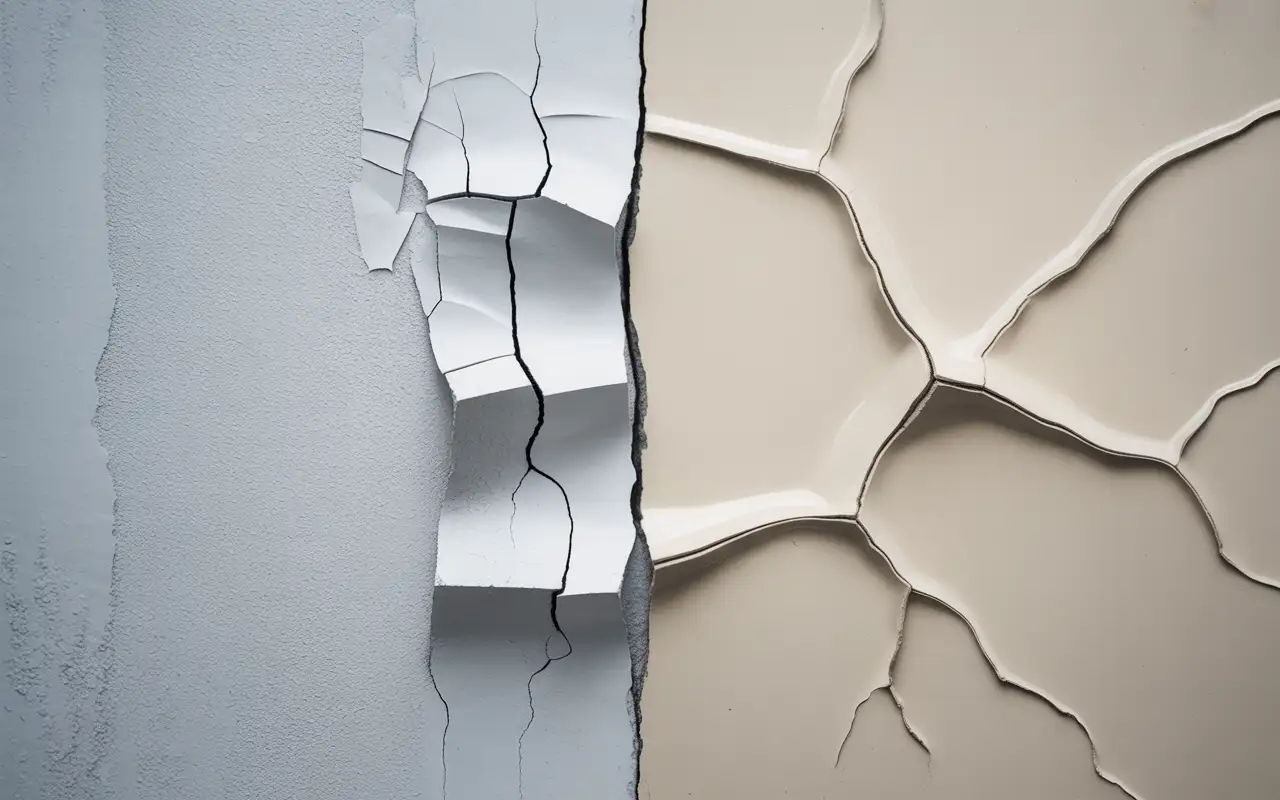Today, we are seeing choices in natural wall surfaces besides painted drywall and wood. While there is some confusion when homeowners try to choose between limewash and whitewash, the more relevant debate revolving around the topic of limewash vs whitewash is which finish gives you the weathered, authentic look, along with the practical needs a person may have for a particular project.
This guide will break down everything you need to know about each of the finishes, including a breakdown of its composition, how to apply it, its costs and the durability of each option. After reading this, you’ll be in a better position to decide which is the best option for your space.
Table of Contents
ToggleWhat Is Whitewashing?

The practice of whitewashing has a long history in American history. Colonial settlers whitewashed frequently and routinely to protect wood, brick, and stone surfaces. It was, and still is, a simple recipe of lime, water, and salt to develop an affordable protective coating.
Composition of Modern Whitewash
In modern contexts, for example, whitewash paint is produced by using hydrated lime and water to create a thin slurry. When a mixed stain is used, a few small binding agents are sometimes added, especially to help adhesion. Many people who like an easy DIY project will use paint and water in a 1:1 or 1:2 ratio to make an easy wash. There are also premixed cans for whitewashing brick if you prefer to go that route. These premixed paints are typically water-based and easy to use on a test piece.
Application Characteristics
For the best results with the application of whitewash, start with clean, dry, and porous surfaces. If working with a rough surface, make sure to vacuum out any dust and fill gaps first. Tackle one small section at a time to ensure you have enough time to adjust coverage. Use a broad masonry paint brush to apply the paint with thin layers. The process of whitewashing is to brush either stain or paint onto the surface thoroughly, then, depending on the look you desire, you can wipe back or thinly cover the paint. Sprayers can work to apply a whitewash, but using a brush will allow for more control in painting on brick joints and wood grain.
Typical Coverage and Material Content
Coverage varies by blend and surface texture. Many DIY paint and water whitewashes cover 150 to 250 square feet per gallon on smooth wood. Very rough bricks might go down to 100 square feet. Always buy a little more in case you want to test or make touch-ups later.
Visual Properties & Aesthetic Outcomes
A whitewash dries flat and chalky looking, with the wood grain showing through. On the brick, it softens the colour and blends visually the harsh contrast. You can always mix with water to adjust how opaque it looks. If you want it brighter, add more coats. A common question is, ‘How do you whitewash a brick fireplace?’ It is actually a simple process. It is about knowing how to follow the steps: typically, clean the face, test on a corner, apply a thin wash, and then wipe with a damp rag until the tone feels just right to you. The process of whitewashing would be the same on a brick fireplace surround as it would be on a brick fireplace mantel or shelves.
Durability & Maintenance Profile
A whitewash finish will not be as durable as paint. Outside, the sun and the elements will cause it to fade more quickly than a painted surface. For example, if whitewash is used over brick in an outside setting, it would wear more rapidly than whitewash applied to inside brick. If applied indoors, it will hold longer but will show wear in high-touch sheen, such as a crisp white shelf or top rail. Maintenance or re-coat of whitewash is easy as well. Clean it, mix up a new batch of whitewash, and then reapply thin coats until you get to the desired finish and opaqueness.
What Is Limewash?
Scientific Background & Composition
The term “limewash” derives from the limestone used to produce quicklime by heating. This quicklime is generally then mixed with water to create either slaked lime water or lime putty. Limewash is made up primarily of calcium hydroxide. The application of limewash to a surface is a process that occurs over time, which is initiated by the introduction of air. The process is called carbonation, and it ultimately converts the coating mentioned above back into calcite. This is why limewash has greater adhesion to mineral walls than many paint products.
Manufacturing & Preparation Methods
The best limewash products are manufactured from aged lime putty and require extensive quality checks. High-quality limewash products will contain fine particles, enabling the product to achieve a soft, even coat over a surface. You can make it yourself, but keep safety in mind. Always add lime to water, never water to lime. You should wear gloves, goggles, and a mask when mixing. Mix until smooth, allowing the product to rest for a time. You should strain the limewash before using it to create a smoother finish.
Unique Characteristics in Application
Limewash requires porous surfaces, such as bricks, stones, and older stucco, to function effectively. Limewash allows a wall to breathe and enables moisture to escape. This moisture escaping the wall assists in drying out after a stain, a significant event in wet climates. The high pH level in lime makes it less hospitable to mould species, as well. In addition, as limewash carbonates, it tends to heal self-healing hairline marks. This is a salty part about using limewash on historic walls.
Distinctive Visual Characteristics
The look is matte and mineral. Brush marks and soft movement show in the finish. Colour has depth because of light bounce in the mineral layer. The tone shifts slightly as it cures. Over time, it forms a gentle patina.
Performance & Longevity Factors
On the right substrate, limewash can last for years with light care. It handles UV better than thin paint washes. It bonds into the wall, not just on top. On dense new cement, bonds can suffer without a mineral primer. On wood, it will not last. Use it on stone surfaces, brick, and lime plaster. Avoid sealed drywall without a proper base.
The Major Differences Between Whitewash and Limewash

To understand the comparison of whitewash vs limewash, we must first look at their essential differences. The raw materials tell the first part of the story. Limewash is made of pure lime putty (putty that has not yet carbonated), mineral pigments, and water. Whitewash is made of hydrated lime, salt, water, and sometimes a binding agent for performance enhancement.
Chemical behaviour is another significant difference between the two finishes. Limewash undergoes true carbonation over time, turning back into limestone. Whitewash primarily dries through evaporation of water from the surface, with few bonds to each finish. This affects how long the finish lasts and how frequently it requires maintenance.
Finally, the application method is similar between the two, but there are significant differences. Both finishes work best on porous surfaces like brick and stone. Limewash requires more care with preparing the surface and application technique than whitewash. For limewash, adhere to the mixing with water specifications from the manufacturer for limewash claims and apply only smaller pieces (while keeping the wet edge).
The surface preparation requirement can vary depending on which finish type you are using. A whitewashing project on a brick fireplace will typically require little more than cleaning up the surface. Limewash will require you to dampen the substrate beforehand, and in some cases, you may want to apply a mist coat before application.
Although there is some overlap in tools, there are also some differences. Both finishes will yield the best results when applied using a masonry paintbrush. Limewash may require special brushes that are designed for lime-based materials. Both finishes are also suitable for spray application, but this requires the right equipment and technique.
Aesthetic outcomes may represent the most significant difference between the finishes. Whitewash provides a uniform, chalky appearance that does not vary much in texture. Limewash has a natural mottled and depth effect that can change in colour and texture depending on the viewing angle and lighting conditions.
There is also a difference in the colour options that are available between the finishes. Whitewash has traditionally been found in either white or off-white colours, and some of the newer formulations may have slight variations by adding pigments into the mix. Limewash accepts the use of mineral pigments quite readily, which allows for a much wider variety of beautiful and natural earth tones and custom colours to be achieved.
In most cases, durability performance favours limewash. When properly applied, limewash can last for 20-30 years on exterior surfaces, while whitewash will need to be reapplied every 3-5 years based on exposure conditions.
The cost analysis of these finishes reveals some interesting trade-offs. Initially, materials for a whitewash application would favorably run approximately ($0.50-$1.50) per square foot, while materials for a limewash application may run about ($2.00-$4.00) per square foot but will last much longer. In addition, if you factor in the costs of upkeep and reapplication, limewash is usually more favourable cost-wise in the long run.
Considering All Your Options to Create a Weathered, Vintage Look?
Beyond the traditional Limewash vs Whitewash, there is not your only option for vintage aesthetic project planning. Milk paint is another natural option with its own distinguishing characteristics. Milk paint is a water-based chemistry that uniquely penetrates porous surfaces and, over time, achieves a beautiful aged patina.
Chalk paint is becoming a popular option for indoor applications. I particularly like it for whitewash cabinet projects and furniture refinishing. It is easier to apply than traditional lime-based finishes; sheer skill level is not a consideration.
Clay-based finishes are also natural alternatives to consider in the planning of a vintage aesthetic project. Clay-based finishes work as a binder with natural clay and mineral pigments. They also have excellent breathability and have some texture variation similar to limewash.
Consideration for your specific project requirements is relevant when making a final decision. The substrate material is a significant factor in achieving the best project finish and experience. Whitewash brick will work well in interior and exterior applications. Stone substrates typically perform better with lime wash due to its superior bonding properties.
The skill level requirements varied significantly between these two options. Whitewashing requires only a basic application process that most do-it-yourselfers can master. Lime washing requires more technique, experience, and skill level to achieve the quality you want as a professional.
Need Something Painted?
For complex jobs, call the pros. Large exterior brick, historic stucco, or a tricky limewash on a tall wall needs skill. If you are in Spring Valley or greater San Diego, our team at San Diego Custom Painting can help. Ask about our interior painting services in San Diego for clean prep, safe materials, and neat results. We also offer home painting services for both interior and exterior projects. Want pricing or a test patch. Reach out for a free estimate and we will guide you.
FAQs
Which is better, limewash or whitewash?
It depends on the wall and the goal. For brick and stone that need to breathe, limewash is best. For wood grain or quick tone changes, whitewash wins. For outdoor bricks that face sun and rain, limewash lasts longer. For small inside projects, whitewash is fast and flexible.
What are the disadvantages of limewash paint?
It needs the right porous base. It takes more coats and time. Color choice is more natural than bright. It can be tricky in hot, dry weather. Plan the work to avoid streaks.
Can mold grow on limewash?
Limewash is high in pH, which is not friendly to mold. It also breathes, which helps walls dry out. If a wall has deep damp or leaks, any finish can fail. Fix moisture first.
How much does limewash cost vs whitewash?
Materials for whitewash are cheaper. Labor for limewash is higher due to more coats. For a fair view, compare cost per year. Limewash can last longer on brick and stone. Whitewash may need more touch ups, but it is fast to refresh.





